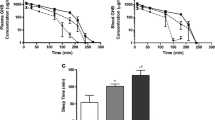Summary
The metabolism of pentobarbitone has been investigated in two healthy volunteers, and the urinary excretion of unchanged drug, and the products of ω and (ω1)-oxidation, quantified for four days after each of three doses to each volunteer. The rates of excretion are discussed in terms which include enzyme induction effects.
Similar content being viewed by others
References
Maynert E.W. and Dawson J.M. (1952): 5-Ethyl-5-(3′-hydroxy-1’-methylbutyl) barbituric acids as metabolites of pentobarbital, J. biol. Chem.,195, 389–395.
Dickert Y.J., Shea P.J. and McCarty L.P. (1966): The synthesis and pharmacological activity of 5-ethyl-5-(3′-hydroxy-1′-methylbutyl)barbituric acid, J. med. Chem.,9, 249.
Maynert E.W. (1969): A racemic form of 5-ethyl-5-(3-hydroxy-1′-methylbutyl) barbituric acid as a metabolite of pentobarbital, J. med. Chem.,12, 180–181.
Carrol F.I. and Mitchell G.N. (1975): Synthesis and absolute stereochemistry of 5-alkyl-5-(3′-hydroxy-1′-methylbutyl)barbituric acid and 5-alkyl-5-(3′-hydroxy-1′-methylbutyl)-2-thiobarbituric acids, J. med. Chem.,18, 37–41.
Carroll F.I. and Philip A. (1971): Synthesis and alkaline decomposition of 5-alkyl-5-(1′-methyl-3′-oxobutyl)barbituric and 2-thiobarbituric acid derivatives, J. med. Chem.,14, 394–396.
Wood H.B. and Horning E.C. (1953): 5-Ethyl-5-(1-methyl-3′-carboxypropyl) barbituric acid and its 2-thio analog. Metabolites from pentobarbital and thiopental, J. Amer. Chem. Soc.,75, 5511–5513.
Ehrnebo M. (1974): Pharmacokinetics and distribution properties of pentobarbital in humans following oral and intravenous administration. J. pharm. Sci.,63, 1114–1118.
Reidenberg M.M., Lowenthal D.T., Briggs W. and Gasparo M. (1976): Pentobarbital elimination in patients with poor renal function. Clin. Pharmac. Ther.,20, 67–71.
Gilbert J.N.T. and Powell J.W. (1976): Enzyme induction effects in the human metabolism of butobarbitone, Eur. J. Drug Metab. Pharmacokin.,1, 188–193.
Baldeo W.C., Gilbert J.N.T. and Powell J.W. (1979): A multi-dose study on the human metabolism of amylobarbitone, Xenobiotica,9, 205–208.
Gilbert J.N.T., Hetherington W.L., Powell J.W. and Whalley W.B. (1975): Metabolism of quinalbarbitone, J. Pharm. Pharmac.,27, 343–347.
Maynert E.W., Foreman R.L. and Watabe T. (1970): Epoxides as obligatory intermediates in the metabolism of olefins to glycols, J. biol. Chem.,245, 5234–5238.
Levin W., Sematinger E., Jacobson M. and Kuntzman R. (1972): Destruction of cytochrome P450 by secobarbital and other barbiturates containing allyl groups. Science,176, 1341–1343.
Cretcher L.H., Koch J.A. and Pittenger W.H. (1925): The synthesis of 5-β-hydroxyethyl-barbituric acid and its alkyl derivatives. J. Amer. Chem. Soc.,47, 3083–3085.
Tang B.K., Inaba T. and Kalow W. (1977): N-Hydroxylation of pentobarbital in man, Drug Metab. Disposition,5, 71–74.
Gilbert J.N.T., Nelmes P.T.J., Powell J.W. and Murray S. (1978): N-Hydroxy-amylobarbitone — a metabolite of amylobarbitone? J. Pharm. Pharmac.,30, 595.
Goldbaum L.R. and Smith P.K. (1954): The interaction of barbiturates with serum albumin and its possible relation to their disposition and pharmacological actions, J. Pharmac. exp. Ther.,111, 197–209.
Pelkonen O. and Kärki N.T. (1973): Effect of physicochemical and pharmacokinetic pronerties of barbiturates on the induction of drug metabolism. Chem. Biol. Interactions,7, 93–99.
Alvan G., Piafsky K., Lind M. and von Bahr C. (1977): Effect of pentobarbital on the disposition of alprenolol. Clin. Pharmac. Ther.,22, 316–321.
Paigen B., Gurtoo H.L., Minowad J. and Paigen K. (1977): Aryl hydrocarbon hydroxylase in cultured human lymphocytes, in Microsomes and Drug Oxidations, ed. Ullrich et al., 418–425, Pergamon Press, Oxford.
Smith R.G., Daves G.D., Lynn R.K. and Gerber N. (1977): Hydantoin ring glucuronidation: characterisation of a new metabolite of 5,5-diphenyl-hydantoin in man and the rat, Biomed. Mass. Spec.,4, 275–279.
Kalow W., Tang B.K., Kadar D. and Inaba T. (1974): Distinctive patterns of amobarbital metabolites. Clin. Pharmac. Ther.,24, 576–582.
Author information
Authors and Affiliations
Rights and permissions
About this article
Cite this article
Baldeo, W.C., Gilbert, J.N.T. & Powell, J.W. Multidose studies in the human metabolism of pentobarbitone. European Journal of Drug Metabolism and Pharmacokinetics 5, 75–80 (1980). https://doi.org/10.1007/BF03189449
Received:
Issue Date:
DOI: https://doi.org/10.1007/BF03189449




